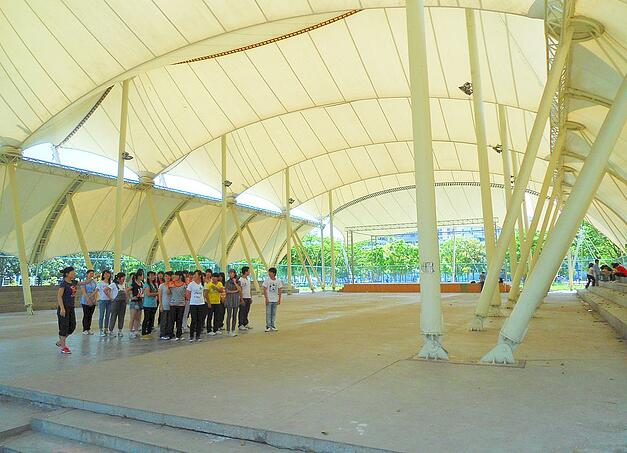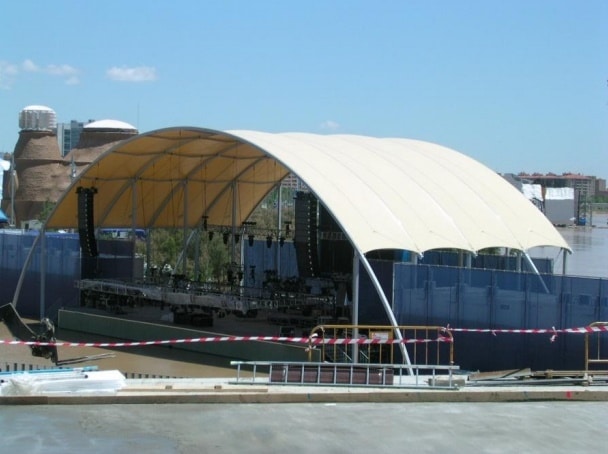Do you know what textile architecture is? In this article, we detail all the characteristics of this type of construction and its possible applications.
Textile architecture is a textile solution based on light structures that have become a great solution to create versatile constructions.
Within textile architecture, we include those works that use large stretched surfaces such as membranes, meshes, or light sheets for their enclosure. Also known as tensile structure, it can be defined as a system based on light structures that are mainly used to make covers. Different rigid materials are used in its manufacture, such as poles and arches, which, in turn, provide stability when combined with flexible materials such as canvas and cables.
Thanks to the use of these components, versatile constructions with a great capacity for adaptability are created. Its use is expanding as new technologies allow the development of more flexible, durable materials with excellent lighting, thermal and structural characteristics.

Textile architecture: uses and advantages
Textile architecture is a construction technique that was used since the beginning of civilizations in order to prepare shelters or homes. Nowadays, with the development of technology and the improvement of materials, it has become a very popular construction method. Mainly, it is used for stretched roofs over large surfaces, since it allows a structural design with large distances between supports. Some of its most common uses are:
- Sports facilities
- airports
- event spaces
- Malls
- Facade enclosure

This type of construction has a number of advantages, including:
- Lightness : its materials are light and flexible. In this way, a light structure is achieved that provides protection against rain and sun.
- Translucency and luminosity : thanks to these structures, natural light can be used, without the need to resort to artificial lighting.
- Durability : its materials are very resistant.
- Quick assembly.
- Low cost of production and maintenance .
- Geometric flexibility and formal beauty .
- Sustainability : both the materials and the construction process do not cause damage to the environment.
Read More: What is Sustainability in Architecture: 7 elements to consider
Read Also: Civil Engineering or Architecture: which one is for me?
What types of textile architecture exist?
In textile architecture, there are two typologies, according to their structural behavior, pneumatic and tensioned. The first is supported by air and refers to inflatable textile elements that can be used as bubbles for ephemeral spaces. Meanwhile, the second is the most common, and work by pure attraction. In tensile architecture, masts, cables, and tensioners are used to achieve the form and function for which they have been designed.
Materials used in the tensile structure
The tensile structure uses a wide variety of materials that are used in these structures such as PES, PVC, PVDF, thermoplastic polymers, and silicone. The latest technologies have made it possible to obtain materials with excellent properties: lighter, stronger, more durable, with better thermal and light behavior. Some membranes have kink resistance and allow collapsible structures. Surface treatments are also applied to make them more reflective, non-stick, and even dirt-repellent.
Read Also: Textile Architecture: Concept And Structural Stability
Some outstanding examples of this type of textile architecture where its excellent structural behavior, great versatility, and unique beauty have been shown to be expressed are the Munich Olympic Stadium, the Zenith concert hall in Strasbourg, the Millennium Dome in London, the Allianz Arena of Bavaria and the Khan Shatyr Leisure Center in Kazakhstan.
Textile architecture applications
Tensile structures can be used to cover any space that is outdoors. Therefore, some of its applications are:
- Tarpaulins for terraces and balconies
- garage enclosures
- covers
- canvas roofs
- Industrial covers
- Awnings for commercial spaces


